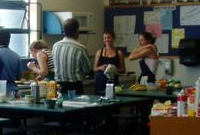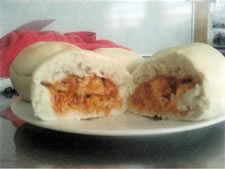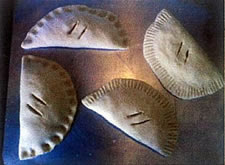Healthy pie-alternatives
 Aleyse Emirali, Elizabeth Burton, Whitney Peterson, and Hannah Richardson
Aleyse Emirali, Elizabeth Burton, Whitney Peterson, and Hannah Richardson
Rangitoto College
Year 13 Food Technology
Teacher: Gill Hedworth
Elizabeth, Whitney, Hannah and Aleyse had previously studied Food and Nutrition but, after a programme change in Year 13, are now enthusiastic about the benefits of Food Technology. They worked as a group and developed individual products for their client, Whitney's father Tony Peterson. Tony, managing director of Leader Products which produces a wide range of convenience foods, wanted to take advantage of the trend for healthier foods and asked the girls to develop a healthy alternative to the ever-popular pie.
A Futureintech Ambassador had talked to the class about how a technologist develops a product. The group visited the Leader Products factory to investigate the range of food products on the market, and discussed the mass production process with a food technologist and the hygiene analysis process with a bacteriologist.
The students had the opportunity at school to consult a nutritionist, who was involved in developing a healthy pie, and a dietician who discussed the nutritional aspects of meat. The group also researched Ministry of Health regulations on commercial food production, and the effects of freezing/reheating on food products. (Students commented on the benefits of researching at the Auckland University of Technology library – see www.Techlink.org.nz/teaching-snapshot/Y12-13-Senior/Rangitoto-AUT.htm )
The girls took apart and analysed some of the popular products from the school tuck shop, and surveyed tuck shop staff and customers about food preferences. They also interviewed the deputy principal, responsible for health and nutrition in the school, as a wider stakeholder.
Working individually, the group tested a range of bread recipes and then developed some of their concept ideas, consulting their client as to which product they should develop. Each student organised her own focus group, comprised of students from all levels, and conducted sensory testing at various stages of the project.
Aleyse developed a chicken naan pocket and trialled a variety of mixtures. She used potatoes to bulk up the filling, and says that although she wanted lots of vegetables she tried to 'hide' them as some people don't like food with vegetables. After testing a range of fillings with her focus group, Aleyse decided to concentrate on an onion and mushroom combination, and to add gravy, both as a filler and because pies have gravy. She tested a wide range of gravy recipes for taste and thickness and experimented with vegetable gravy, but found this too chunky; however when the vegetables were cut smaller no-one liked it! Aleyse concluded that people are less likely to enjoy something with multiple ingredients and that it was better to stick to a basic recipe.
Aleyse next developed and tested dough recipes, to find something that not only tasted good, but also held the filling properly without being too heavy. She decided to make a healthier version of naan bread as the casing for her mixture.

Elizabeth also commented that some people won't buy food that looks too full of vegetables, and says it was a challenge designing concepts that fitted health regulations, were convenient to eat and that people liked. She was planning to concentrate on her tortilla wrap concept but it didn't work as she'd hoped and, after investigating the range of convenience foods at a supermarket, she decided to adapt pita pockets for her Hawaiian chicken pizza case instead. Elizabeth developed a pizza dough of mostly wholemeal flour, noting that the additional fibre was a good costing point as it makes people feel full sooner than when eating a white flour product.
After trialling different fillings and sauces, Elizabeth settled on a mushroom, cheese and tomato mix flavoured with garlic and herbs. She used Edam cheese due to its lower fat content and pineapple juice as a substitute for sugar which would also take the 'bite' away from the tomatoes – noting that her age group often doesn't find that 'bite' appealing. Elizabeth followed Leader Products' example and froze her mixture in a mould she borrowed from them, which made it easier to shape.
Whitney developed a butter chicken tortilla. She wanted to make a curry mixture and tried different varieties – she visited a local Indian restaurant to ask about customer preferences and says that finding out butter chicken was the most popular dish gave her more direction in developing her own food.
After tasting some curries wrapped in tortillas, and some frittatas, Whitney's focus group agreed that the butter chicken tortilla was the best so she focussed on developing that as her final product. Whitney made a lot of butter chicken versions and eventually decided that because there wasn't a lot of filling, due to the cost of the chicken, that she needed to bulk the mixture up and added potato. Whitney also froze her mixture in a mould which she says made it easier to handle and made the product look a lot better.
 Hannah worked on a number of concepts (Scotch egg, lasagne topper, savoury tart, chicken or bacon calzone). After discussion with her client, she decided to develop the chicken calzone concept, and experimented with a variety of fillings – some of which she tested with her focus group. As a result of this, Hannah decided to continue with the courgette, mushroom, and capsicum mixture added to the chicken. As well as taste she also wanted a texture pleasing to most people, so trialled and tested the mixture for viscosity. Hannah then tested different dough recipes, adding varying amounts of wholemeal flour to find a ratio that her testers liked, and working out how thin she could make the dough while maintaining its function as a casing.
Hannah worked on a number of concepts (Scotch egg, lasagne topper, savoury tart, chicken or bacon calzone). After discussion with her client, she decided to develop the chicken calzone concept, and experimented with a variety of fillings – some of which she tested with her focus group. As a result of this, Hannah decided to continue with the courgette, mushroom, and capsicum mixture added to the chicken. As well as taste she also wanted a texture pleasing to most people, so trialled and tested the mixture for viscosity. Hannah then tested different dough recipes, adding varying amounts of wholemeal flour to find a ratio that her testers liked, and working out how thin she could make the dough while maintaining its function as a casing.
The four students were all pleased with their results and Tony, when he visited for a presentation of their developed products, was enthusiastic about their work and what they had achieved in Food Technology. "To see them learning things in school that are part of my business – analysing nutritional value, conducting surveys, doing costings – that's fantastic."
Teacher comment
The students really loved the move to Food Technology and definitely rose to the challenge. They were ready to move on from Food and Nutrition, although that knowledge was fabulous in their development work. They did a lot of research and a lot of modelling, and as well as consulting Tony they were constantly getting stakeholder feedback from the target market, in terms of sensory testing and questionnaires They've done the costing, HACCP, manufacturing specifications – it's just what you do in the food industry and they could make a product like that. Their work shows what Technology is all about – it's the creativity, the development process.

